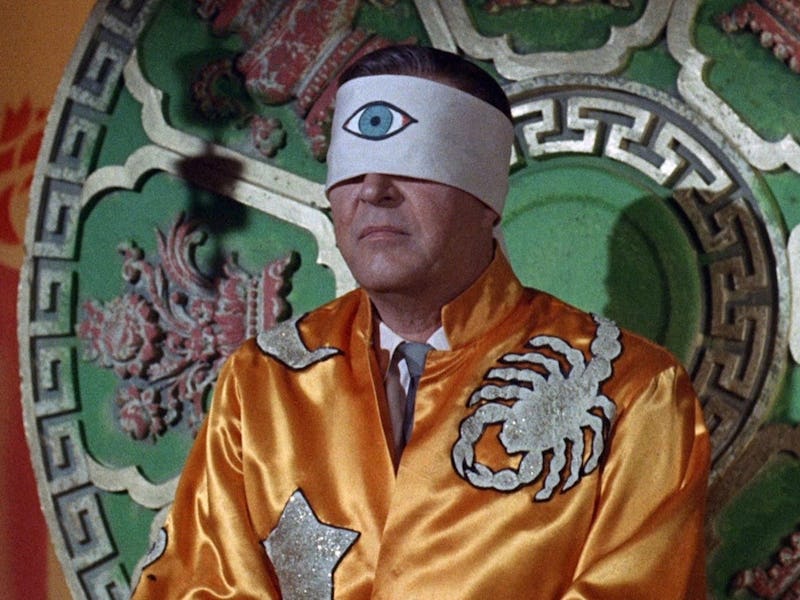Roger Corman’s Most Lurid Movie Still Shocks Decades Later
We hope eye stuff doesn’t make you uncomfortable.

As Les Baxter’s electronic score swells, a large, bloodshot eyeball fills the black frame for nearly 30 seconds. Next, a detached eyeball boils in a beaker filled with pink fluid. Finally, there’s a close-up of a pair of sad, blue eyes. The opening sequence perfectly sets the tone for one of prolific director Roger Corman’s weirdest and most stylish films.
The sad blue eyes in 1963’s X: The Man with the X-ray Eyes belong to Academy Award-winning actor Ray Milland, in a role that straddles the line between trash and high art. He plays Dr. James Xavier, a scientist working on a serum that will allow humans to see ultraviolet and X-ray wavelengths. Like fellow Corman horror great Vincent Price, Milland brings an honest intensity and pathos to what could have been a stereotypical mad scientist.
In an Uproxx interview, Corman said that when he was developing the film’s outline he wanted to craft a story about a man who can “see through things, and see through things increasingly,” and that in one iteration his lead happened to a jazz musician who took too many drugs. Although Corman landed on a more traditional scientist, he did incorporate aspects of psychedelic drug culture that would later appear in his 1967 film The Trip. Filmed with the early tinting process Pathécolor, cinematographer Floyd Crosby (appropriately, the father of musician David Crosby) used kaleidoscopic filters and colored gels to emulate what vision that goes beyond the normal light spectrum might be like.
Corman had just come off a slew of Edgar Allan Poe adaptations, and while The Man with the X-ray Eyes is modern philosophical sci-fi, it’s still laser-focused on a man’s descent into madness. After a battle over funding is lost, and an experiment kills a monkey when the poor animal can’t process what it’s just seen, Dr. Xavier begins testing his eye drops on himself. At first, things go well. Dr. Xavier attends a groovy cocktail party with his lady friend Dr. Diane Fairfax (Diana Van der Vlis), where the randy doctor can see through everyone’s outfits. Corman pushes cinema into the swingin’ sixties, filming nude women from the neck up or with their backs to the camera.
The serum also allows Xavier to do amazing things, like perform a life-saving surgery on a young girl. But his brusque behavior and delusions of grandeur rub his colleagues the wrong way, and a friend soon winds up dead. It’s here we see the true strength of Milland’s acting talent. He can utter lines like “With my new eyes, we’ll explore all the mysteries of creation,” in a way that makes them sound almost Shakespearean.
X’s effects are simple, but haunting.
The latter half of the film finds Dr. Xavier in more grotesque settings. After fleeing the accident, he finds work as a carnival spiritualist, like an even more perverse twist on Nightmare Alley. Corman brings this setting to life with brightly colored belly dancers in primary colors and a large crowd of extras, which helps belie the film’s modest budget. Milland’s white blindfold emblazoned with a third eye, along with his yellow satin robe bejeweled with silver zodiac symbols, is perhaps the most instantly iconic costume in Corman’s long filmography.
Dr. Xavier’s journey takes on further Shakespearean depths as he and his sketchy manager (Don Rickles) set up shop in a dingy part of town, where Dr. Xavier works as a miracle man for the destitute. Even while perpetually sporting thick, dark glasses, all Dr. Xavier can see is the sickness in people. At night, he sees through his eyelids. Desolate, he prays to know darkness again.
Finally, in a sequence that feels in conversation with something like Wise Blood, Flannery O’Connor’s 1952 novel about anti-religious fervor, Dr. Xavier finds himself at the end of his rope. His eyes now fully black from the serum, he flees into the Nevada desert and discovers a frenzied religious revival tent. When the preacher asks if he’s come to be saved, he says he’s “come to share what he’s seen.” Psychedelic colors swirl as the preacher fervently recites the gospel, “If thine eye offends thee, pluck it out,” and Dr. Xavier finally succumbs to his madness. The shocking ending cements X: The Man with the X-ray Eyes as a high point amongst Corman’s supposedly “low” films, proving it doesn’t take a big budget to make a film with a grand thematic scope.